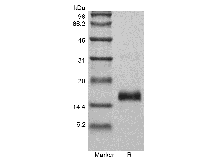- Synonyms
- Vascular endothelial growth factor isoform 120
- Source
- Escherichia coli.
- Molecular Weight
- Approximately 28.4 kDa, a disulfide-linked homodimeric protein consisting of two 121 amino acid polypeptide chains with Met at N-terminus.
- AA Sequence
- MAPTTEGEQK SHEVIKFMDV YQRSYCRPIE TLVDIFQEYP DEIEYIFKPS CVPLMRCAGC CNDEALECVP TSESNITMQI MRIKPHQSQH IGEMSFLQHS RCECRPKKDR TKPEKCDKPR R
- Purity
- > 96 % by SDS-PAGE and HPLC analyses.
- Biological Activity
- Fully biologically active when compared to standard. The ED50 as determined by a cell proliferation assay using human umbilical vein endothelial cells(HUVEC) is less than 5 ng/ml, corresponding to a specific activity of > 2.0 × 105 IU/mg.
- Physical Appearance
- Sterile Filtered White lyophilized (freeze-dried) powder.
- Formulation
- Lyophilized from a 0.2 μm filtered solution in PBS, pH 7.4.
- Endotoxin
- Less than 1 EU/μg of rMuVEGF120 as determined by LAL method.
- Reconstitution
- We recommend that this vial be briefly centrifuged prior to opening to bring the contents to the bottom. Reconstitute in sterile distilled water or aqueous buffer containing 0.1 % BSA to a concentration of 0.1-1.0 mg/mL. Stock solutions should be apportioned into working aliquots and stored at ≤ -20 °C. Further dilutions should be made in appropriate buffered solutions.
- Stability & Storage
- Use a manual defrost freezer and avoid repeated freeze-thaw cycles.
- 12 months from date of receipt, -20 to -70 °C as supplied.
- 1 month, 2 to 8 °C under sterile conditions after reconstitution.
- 3 months, -20 to -70 °C under sterile conditions after reconstitution.
- Usage
- This material is offered by Shanghai PrimeGene Bio-Tech for research, laboratory or further evaluation purposes. NOT FOR HUMAN USE.
- Reference
- 1. Leung DW, Cachianes G, Kuang WJ, et al. 1989. Science. 246:1306-9.
2. Byrne AM, Bouchier-Hayes DJ, Harmey JH. 2005. J Cell Mol Med. 9:777-94.
3. Robinson CJ, Stringer SE. 2001. J Cell Sci. 114:853-65.
- Background
- Vascular Endothelial Growth Factor is a sub-family of growth factors produced by cells that stimulates vasculogenesis and angiogenesis. VEGF's normal function is to create new blood vessels during embryonic development, new blood vessels after injury, muscle following exercise, and new vessels (collateral circulation) to bypass blocked vessels. VEGF signals through the three receptors: fms-like tyrosine kinase (flt-1), KDR gene product (the murine homolog of KDR is the flk-1 gene product) and the flt4 gene product. Mouse express alternately spliced isoforms of 120, 164, 182 amino acids (a.a.) in length. The VEGF120 shares 98 % a.a. sequence identity with corresponding regions of rat, 89 % with canine, feline, equine and porcine, and 87 % with human, ovine and bovine VEGF, respectively.








 COA Application
COA Application


